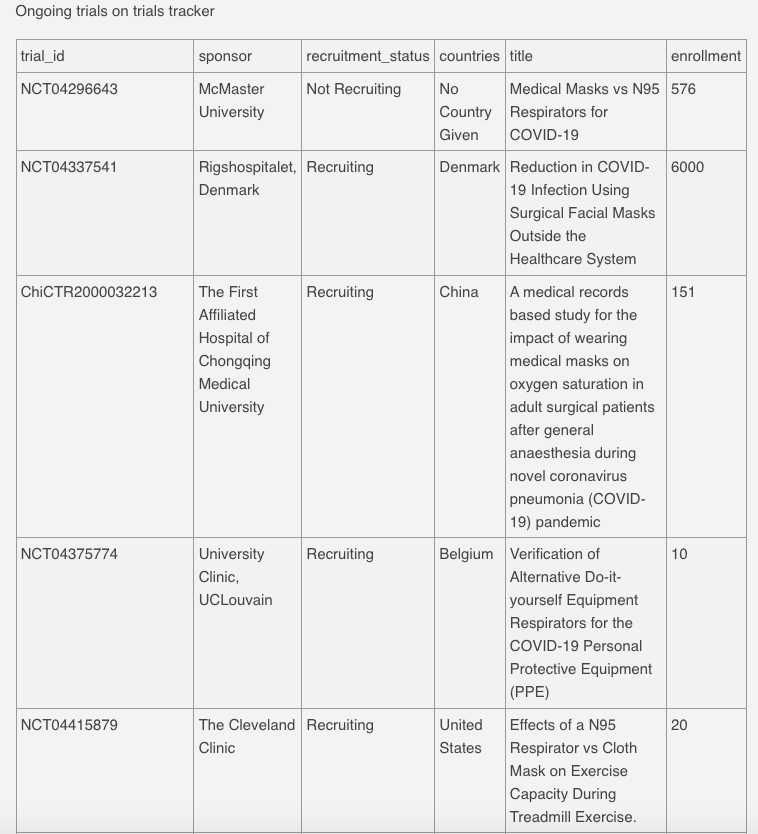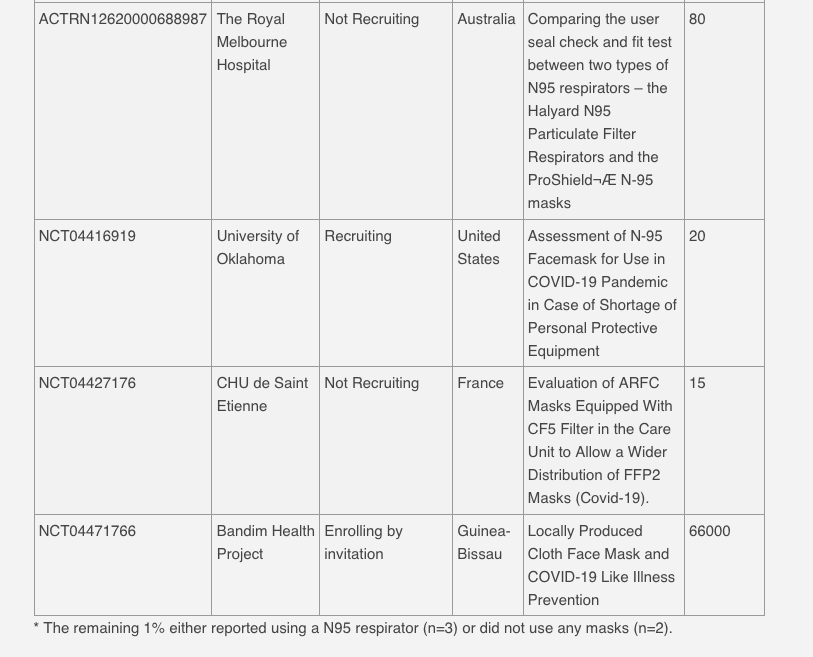July 23, 2020
Tom Jefferson, Carl Heneghan
The increasing polarised and politicised views 1 on whether to wear masks in public during the current COVID-19 crisis hides a bitter truth on the state of contemporary research and the value we pose on clinical evidence to guide our decisions.
In 2010, at the end of the last influenza pandemic, there were six published randomised controlled trials with 4,147 participants focusing on the benefits of different types of masks. 2 Two were done in healthcare workers and four in family or student clusters. The face mask trials for influenza-like illness (ILI) reported poor compliance, rarely reported harms and revealed the pressing need for future trials.
Despite the clear requirement to carry out further large, pragmatic trials a decade later, only six had been published: five in healthcare workers and one in pilgrims. 3 This recent crop of trials added 9,112 participants to the total randomised denominator of 13,259 and showed that masks alone have no significant effect in interrupting the spread of ILI or influenza in the general population, nor in healthcare workers.
The design of these twelve trials differed: viral circulation was usually variable; none had been conducted during a pandemic. Outcomes were defined and reported in seven different ways, making comparison difficult. It is debatable whether any of these results could be applied to the transmission of SARs-CoV-2. Only one randomised trial (n=569) included cloth masks. This trial found ILI rates were 13 times higher in Vietnamese hospital workers allocated to cloth masks compared to medical/surgical masks, RR 13.25, (95%CI 1.74 to 100.97) and over three times higher when compared to no masks, RR 3.49 (95%CI 1.00 to 12.17). 4
In the study, the control group was asked to continue with their normal practices, which may or may not have included mask-wearing. Mask wearing was measured and documented for all participants, including the control arm. 170/458 (37%) used medical masks in the control arm, 38/458 (8%) used cloth masks, and 245/458 (53%) used a combination of both medical and cloth masks during the study period. *
After adjusting for other factors, ILI (RR=6.64, 95% CI 1.45 to 28.65) and laboratory-confirmed virus (RR=1.72, 95% CI 1.01 to 2.94) remained significantly higher in the cloth masks group compared with the medical masks group.
It would appear that despite two decades of pandemic preparedness, there is considerable uncertainty as to the value of wearing masks. For instance, high rates of infection with cloth masks could be due to harms caused by cloth masks, or benefits of medical masks. The numerous systematic reviews that have been recently published all include the same evidence base so unsurprisingly broadly reach the same conclusions. 2 However, recent reviews using lower quality evidence found masks to be effective. Whilst also recommending robust randomised trials to inform the evidence for these interventions. 5
Many countries have gone onto mandate masks for the public in various settings. Several others – Denmark, and Norway – generally do not. Norway’s Institute for Public Health reported that if masks did work then any difference in infection rates would be small when infection rates are low: assuming 20% asymptomatics and a risk reduction of 40% for wearing masks, 200 000 people would need to wear one to prevent one new infection per week. 6
What do scientists do in the face of uncertainty on the value of global interventions? Usually, they seek an answer with adequately designed and swiftly implemented clinical studies as has been partly achieved with pharmaceuticals. We consider it is unwise to infer causation based on regional geographical observations as several proponents of masks have done. Spikes in cases can easily refute correlations, compliance with masks and other measures is often variable, and confounders cannot be accounted for in such observational research.
A search of the COVID trials tracker reveals nine registered trials of which five are currently recruiting participants and one enrolling participants by invitation. 7 In Denmark, where masks are advised for those who break self-isolation to go out to take a test, a randomised trial including 6,000 participants is assessing reductions in COVID-19 Infection Using Surgical Facial Masks Outside the Healthcare System. In Guinea-Bissau in West Africa, the Bandim Health Project is leading a 66,000 person trial – although not yet recruiting – on cloth face masks.
The small number of trials and lateness in the pandemic cycle is unlikely to give us reasonably clear answers and guide decision-makers. This abandonment of the scientific modus operandi and lack of foresight has left the field wide open for the play of opinions, radical views and political influence.


Disclosure:
Tom Jefferson is an Epidemiologist. Disclosure statement is here
Carl Heneghan is Professor of Evidence-Based Medicine, University of Oxford, Director of the Centre for Evidence-Based Medicine and Editor in Chief of BMJ EBM
(Full bio and disclosure statement here)
The views expressed in this viewpoint represent the views of the authors and not necessarily those of the host institution, the NHS, the NIHR, or the Department of Health.
References
- The World Is Masking Up, Some Are Opting Out By Elaine He and Lionel Laurent https://www.bloomberg.com/graphics/2020-opinion-coronavirus-global-face-mask-adoption/?utm_medium=email&utm_source=newsletter&utm_term=200717&utm_campaign=sharetheviewAccessed 19th July
- Jefferson T, Del Mar CB, Dooley L, Ferroni E, Al-Ansary LA, Bawazeer GA, van Driel ML, Nair S, Jones MA, Thorning S, Conly JM. Physical interventions to interrupt or reduce the spread of respiratory viruses. Cochrane Database of Systematic Reviews 2011, Issue 7. Art. No.: CD006207. DOI: 10.1002/14651858.CD006207.pub4
- Physical interventions to interrupt or reduce the spread of respiratory viruses. Part 1 – Face masks, eye protection and person distancing: systematic review and meta-analysis Tom Jefferson, Mark Jones, Lubna A Al Ansari, Ghada Bawazeer, Elaine Beller, Justin Clark, John Conly, Chris Del Mar, Elisabeth Dooley, Eliana Ferroni, Paul Glasziou, Tammy Hoffman, Sarah Thorning, Mieke Van Driel medRxiv 2020.03.30.20047217; doi: https://doi.org/10.1101/2020.03.30.20047217
- . MacIntyre CR, Seale H, Dung TC, et al. A cluster randomised trial of cloth masks compared with medical masks in healthcare workers. BMJ Open 2015;5(4):e006577. doi: 10.1136/bmjopen2014-006577. [published Online First: 2015/04/24]
- Physical distancing, face masks, and eye protection to prevent person-to-person transmission of SARS-CoV-2 and COVID-19: a systematic review and meta-analysis Chu, Derek KChu, Derek K et al. The Lancet, Volume 395, Issue 10242, 1973 – 1987
- Should individuals in the community without respiratory symptoms wear facemasks to reduce the spread of COVID-19? Norwegian Institute of Public Health https://www.fhi.no/globalassets/dokumenterfiler/rapporter/2020/should-individuals-in-the-community-without-respiratory-symptoms-wear-facemasks-to-reduce-the-spread-of-covid-19-report-2020.pdfAccessed 19th July
- https://covid19.trialstracker.net/ Accessed 19th July
- https://clinicaltrials.gov/ct2/show/NCT04471766?term=masks+and+COVID-19&draw=2&rank=1Accessed 19th July
